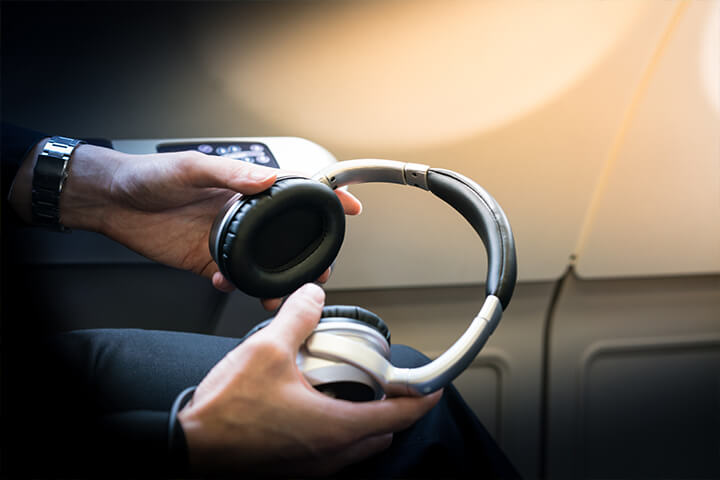What is Noise Cancelling Technology?
7 Sep
2018
Audio hindrances are categorized into two main categories, that is, noise and distortions. Noise is generally the additional signal that decreases the quality of useful signal. Furthermore, distortion changes everything from the original signal. Some types of distortions completely destroy the useful information and cannot be restored. To deal with such kinds of problems, the concept of noise cancelling technology is introduced. Also, the interference of such noises in headphones are reduced by using the active noise controlling method. These methods use attenuators to reduce the noisy signal by amplifying the real voice signal. Moreover, they are used in microphones and headphones.
There are two broad types of noise cancellation technology. Out of this, one uses mics to communicate with the other end. For instance, in a nutshell, type of headphone, the digital algorithm is used to eliminate the surrounding noise and deliver only the voice signal to the end user. Furthermore, the second type of noise cancelling is used in headphones that are designed specifically to protect the user from the disturbed environmental noise.
How do Headphones Achieve Noise Cancelling?
Major headphones use active and passive type of noise cancellation for their reliable operation. The active noise cancelling uses more advanced features, such as aural overlap and destructive interference, to target and attenuate background noise. These active type methods simply build a mirror sound signal that helps to reduce the level of noise drastically. This is also majorly used for steady and low-frequency sound applications.
Moreover, the passive noise cancellation in headphones is achieved by designing headsets with different physical features, such as material used and construction of wearing. This modification results in blocking sound waves to some extent of about 15 to 20 decibels (DB). These kinds of passive noise-canceling headphones are specially built by dropping out ambient noise to focus more on someone’s talking and music. Thus, such kind of passive noise cancellation headphones are best for filtering out irregular, external, and high-frequency sounds that helps to achieve qualitative sound by preventing noise or distorted signals. Nevertheless, maximum effectiveness in noise is attained by combining active and passive noise cancellation.
What’s inside the Noise Cancelling Headphones?
Batteries - The noise-canceling electronics equipment is battery-powered.
Microphone - These are mounted on the ear cup and used to receive external sound waves that are ambient in nature, which originate from the traffic, crowd, machinery, and others.
Noise-Cancelling Circuitry - These circuitry analyses the disturbed noise and uses this information to create a sound wave that counteracts it. The new sound wave generated by this circuitry is exactly 180 degrees out of phase for cancelling out the noise signal. Electronics in the earpiece create a noise-cancelling wave that is the exact opposite to the ambient noise captured by the microphone. This wave acts similar to a noise eraser: it cancels out the unwanted sounds without falling back on the primary playback audio.
Speaker - This speaker receives the newly creates sound waves and plays them into the ear buds.
New Approaches for Noise Cancelling Headphones
The mobile phone plays an important and vital role in modern day-to-day life. The new age headphones, such as Sony, JBL Everest elite, AKG, tribit xfree, and others, have been boosting the growth of the market. Increase in the adoption of smartphones, as they offer effective connectivity to the digital world, majorly drives the market. Rise in demand for wireless accessories also boosts the market growth. This increase in demand is attributed to the change in customer preferences to listen to music on portable devices, such as smartphones and tablets.
According to a recent report published by Allied Market Research, titled, Mobile Phone Accessories Market, this market was valued at $217,278 million in 2016, and is projected to reach at $255,149 million by 2023, growing at a CAGR of 2.3% from 2017 to 2023.

Koyel Ghosh
Author’s Bio- Koyel Ghosh is a blogger with a strong passion and enjoys writing in miscellaneous domains, as she believes it lets her explore a wide variety of niches. She has an innate interest in creativity and enjoys experimenting with different writing styles. A writer who never stops imagining, she has been serving the corporate industry for the last five years.
Avenue: Entire Library membership of Allied Market Research Reports at your disposal
- Avenue is an innovative subscription-based online report database.
- Avail an online access to the entire library of syndicated reports on more than 2,000 niche industries and company profiles on more than 12,000 firms across 11 domains.
- A cost-effective model tailored for entrepreneurs, investors, and students & researchers at universities.
- Request customizations, suggest new reports, and avail analyst support as per your requirements.
- Get an access to the library of reports at any time from any device and anywhere.
Related Post
-
How are Submarine Cables Transforming Global Connectivity with Enhanced User Experience?
-
How Integrating Advanced AC Electric Motors Does Optimize Equipment Potential?
-
How Aerospace Raw Materials Are Evolving with New Processes and Innovations
-
Engineering Evolution of Space Rovers: Focus on Design, Functions, and Field Performance
-
Pressure-Sensitive Adhesives: How They Shape Modern Industrial Applications
-
Understanding the Use and Development of Nonwoven Fabrics in Different Applications
-
How Industrial Fasteners Are Adapting to New Engineering Needs
-
Understanding Hazmat Suits: Exploring Industrial Use, Design, and Developments
-
How Is Building Information Modeling Transforming the Future of Construction?
-
Threat Intelligence: A Critical Tool to Mitigate Cyberattacks









